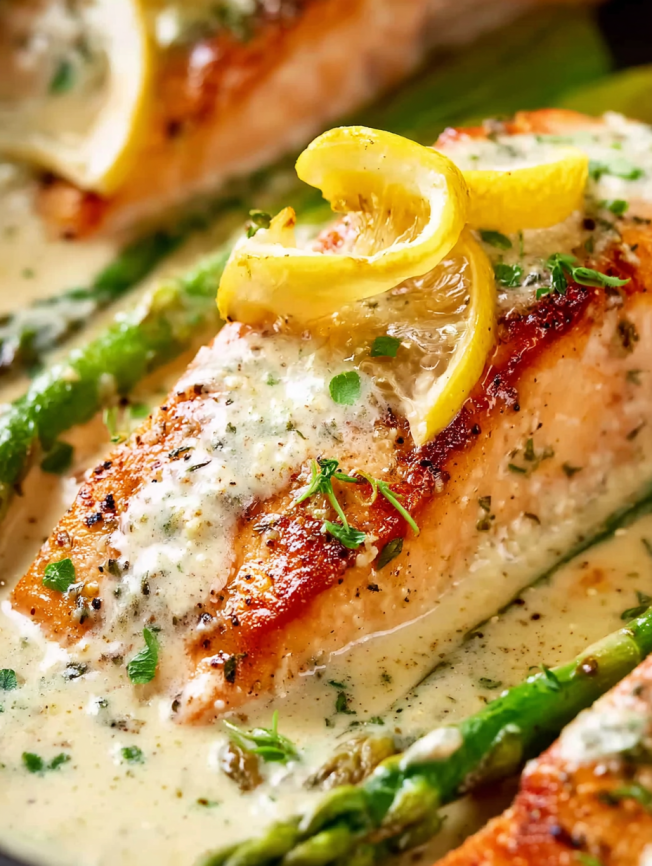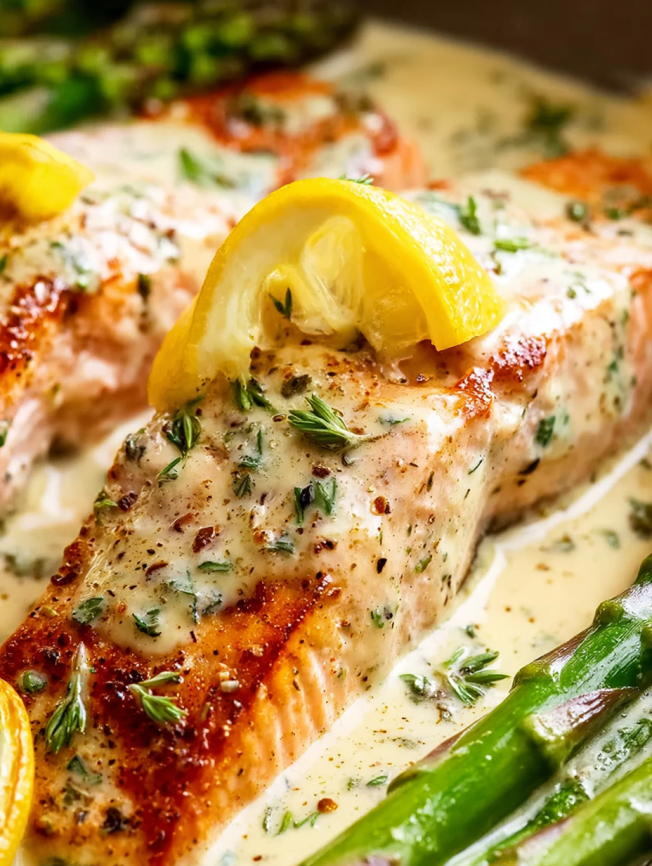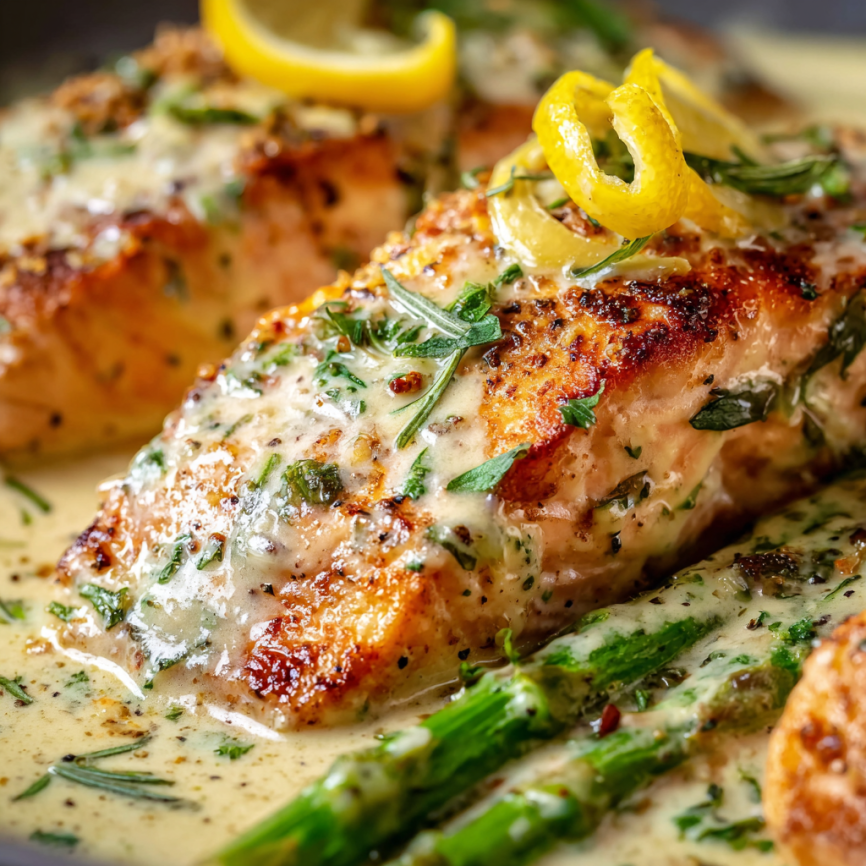There’s something magical about the combination of perfectly seared salmon and a velvety Dijon cream sauce that transforms an ordinary weeknight into something extraordinary. This recipe came to me during one of those frantic evenings when I needed to impress unexpected dinner guests but had limited time. What started as a desperate attempt to elevate simple salmon fillets has become my go-to dish for both special occasions and busy weeknights.
The beauty of this creamy Dijon salmon lies in its simplicity – tender, flaky fish paired with a luxurious sauce that’s both tangy and rich. Moreover, it’s ready in just 20 minutes, making it perfect for those moments when you want restaurant-quality results without the restaurant wait time.
Why You’ll Fall in Love with This Recipe
Quick and Impressive
First and foremost, this dish delivers maximum impact with minimal effort. The entire meal comes together in one pan, which means less cleanup and more time to enjoy your perfectly cooked salmon. Additionally, the cooking process is straightforward enough for beginners yet sophisticated enough to satisfy experienced home cooks.
Keto and Low-Carb Friendly
For those following a ketogenic or low-carb lifestyle, this recipe is a dream come true. The creamy sauce relies on heavy cream and butter rather than flour-based thickeners, keeping the carb count impressively low while maintaining incredible richness. Furthermore, the asparagus adds essential nutrients without compromising your dietary goals.
Versatile and Customizable
What makes this recipe truly special is its adaptability. You can easily swap herbs, adjust the Dijon intensity, or even substitute the asparagus with your favorite vegetables. The sauce itself is so delicious that it works beautifully with other proteins like chicken or pork tenderloin.
Essential Ingredients
For the Salmon
- 1 tablespoon olive oil – Creates the perfect searing base
- 1 tablespoon unsalted butter – Adds richness and helps with browning
- 21 ounces salmon fillets – Skin-on or off, your preference
- Salt and cracked pepper – Essential seasonings
- 1 teaspoon garlic powder – Enhances the savory profile
- 1/2 teaspoon mild paprika – Adds subtle warmth and color
For the Creamy Dijon Sauce
- 1 tablespoon unsalted butter – Base for sautéing garlic
- 4 cloves garlic, minced – Aromatic foundation
- 3/4 cup low-sodium chicken stock – Builds flavor depth
- 1 cup heavy cream – Creates luxurious texture
- 1 heaped tablespoon Dijon mustard – The star ingredient
- 2 tablespoons fresh parsley, chopped – Bright finishing touch
- 1 pound asparagus, trimmed – Perfectly complementary vegetable
- 3 lemon wedges – For serving
Step-by-Step Instructions
Preparing the Salmon
Begin by patting your salmon fillets completely dry with paper towels – this crucial step ensures a beautiful sear. Next, season the fish generously on all sides with salt, pepper, garlic powder, and paprika. The seasoning should be applied just before cooking to prevent moisture from being drawn out.
Heat olive oil and butter in a large skillet over medium-high heat until the mixture is hot and shimmering. Carefully place the salmon fillets flesh-side down first, leaving space between each piece to avoid overcrowding. Allow the salmon to sear undisturbed for 5 minutes, or until cooked halfway through.
Creating the Perfect Sear
Flip the salmon carefully and continue cooking for an additional 3-4 minutes, depending on your preferred doneness. The key is to let the fish cook without moving it, which creates that coveted golden crust. Once cooked to your liking, remove the salmon from the pan and set aside, but keep all those flavorful pan juices – they’re liquid gold for your sauce.
Building the Creamy Dijon Sauce
Return the pan to medium-high heat and add the tablespoon of butter to the remaining juices. Once melted, add the minced garlic and sauté for about 30 seconds until fragrant. Be careful not to let it brown, as burned garlic will make the sauce bitter.
Pour in the chicken stock and let it bubble away, reducing by half while scraping up any browned bits from the bottom of the pan. These caramelized bits add incredible depth to your sauce. Reduce the heat to low-medium and whisk in the Dijon mustard, heavy cream, and fresh parsley.
Finishing Touches
Add the asparagus to the creamy sauce and bring everything to a gentle simmer. Stir occasionally as the asparagus cooks and the sauce thickens, which should take about 3-4 minutes. Season with salt and pepper to taste.
Finally, nestle the salmon back into the pan, sprinkle with additional parsley, and give the sauce one final taste test. Adjust seasonings as needed before serving immediately.

Perfect Serving Suggestions
Classic Presentation
Serve this elegant dish with the asparagus arranged alongside the salmon, generously spooned with the creamy Dijon sauce. The bright green asparagus creates a beautiful color contrast against the golden salmon and pale cream sauce.
Complementary Sides
While the asparagus provides excellent vegetable accompaniment, consider adding cauliflower mash for a low-carb alternative to mashed potatoes. Alternatively, a simple side of roasted Brussels sprouts or green beans would complement the rich flavors beautifully.
Wine Pairing
A crisp Sauvignon Blanc or buttery Chardonnay pairs wonderfully with this dish, echoing the creamy richness while cutting through the sauce’s decadence.
Recipe Variations to Try
Wine-Enhanced Version
For an extra layer of sophistication, substitute the chicken stock with a good quality dry white wine such as Pinot Grigio or Chardonnay. The wine adds complexity and a subtle acidity that balances the cream beautifully.
Herb Alternatives
While parsley provides a fresh, clean finish, don’t hesitate to experiment with other herbs. Dill creates a Scandinavian-inspired flavor profile, while basil adds Mediterranean warmth. Chives offer a mild onion note, and thyme brings earthy sophistication.
Lighter Version
For a lighter sauce, substitute heavy cream with half-and-half or even evaporated milk. Just be careful not to bring the sauce to a rolling boil, as it may curdle. This modification reduces calories while maintaining much of the original richness.
Make-Ahead Tips
Prep Strategy
While this dish is best served immediately, you can prepare several components ahead of time. Season the salmon and store it covered in the refrigerator for up to 4 hours before cooking. Additionally, trim the asparagus and mince the garlic earlier in the day.
Sauce Preparation
The Dijon cream sauce can be made up to 2 hours ahead and gently reheated when ready to serve. If the sauce separates slightly during reheating, whisk in a tablespoon of warm cream to bring it back together.
Storage Guidelines
Leftovers can be stored in an airtight container in the refrigerator for up to 3 days. When reheating, use low heat and add a splash of cream or stock to restore the sauce’s original consistency.
Professional Tips and Notes
Wine Substitution
Transform this dish into something even more special by replacing the chicken stock with dry white wine. The alcohol cooks off during the reduction process, leaving behind concentrated flavor that elevates the entire dish.
Cream Alternatives
Heavy cream creates the richest sauce, but half-and-half works beautifully for a lighter version. For those watching calories, evaporated milk provides creaminess with fewer calories. However, be gentle with the heat to prevent curdling.
Thickening Options
If you prefer a thicker sauce, create a slurry by whisking 1 teaspoon of cornstarch with 1 tablespoon of water until completely smooth. Stir this mixture into the center of the pan and cook until the sauce reaches your desired consistency.

Frequently Asked Questions
Q: Can I use frozen salmon for this recipe? A: Absolutely! Just make sure to thaw the salmon completely and pat it thoroughly dry before seasoning. Frozen salmon often releases more moisture, so extra drying time is crucial for achieving that perfect sear.
Q: What if I don’t have Dijon mustard? A: While Dijon provides the signature tangy flavor, you can substitute with whole grain mustard for texture or even yellow mustard in a pinch. Start with less and adjust to taste, as different mustards vary in intensity.
Q: Can I make this dairy-free? A: For a dairy-free version, substitute the butter with olive oil and use coconut cream instead of heavy cream. The flavor will be different but still delicious, with a subtle coconut undertone.
Q: How do I know when the salmon is perfectly cooked? A: Salmon is done when it flakes easily with a fork and reaches an internal temperature of 145°F (63°C). The flesh should be opaque and slightly firm to the touch. Remember, it will continue cooking slightly from residual heat.
Q: Can I use a different vegetable instead of asparagus? A: Certainly! Broccoli, green beans, or Brussels sprouts work wonderfully. Just adjust the cooking time accordingly – denser vegetables may need a few extra minutes to become tender.
Q: What’s the best way to reheat leftovers? A: Reheat gently in a skillet over low heat, adding a splash of cream or stock to restore the sauce’s consistency. Avoid the microwave if possible, as it can make the salmon rubbery and cause the sauce to separate.
Prep Time: 10 minutes
Cook Time: 10 minutes
Total Time: 20 minutes
Servings: 4 people
Nutrition per serving: 537 calories | 10g carbohydrates | 35g protein | 41g fat

